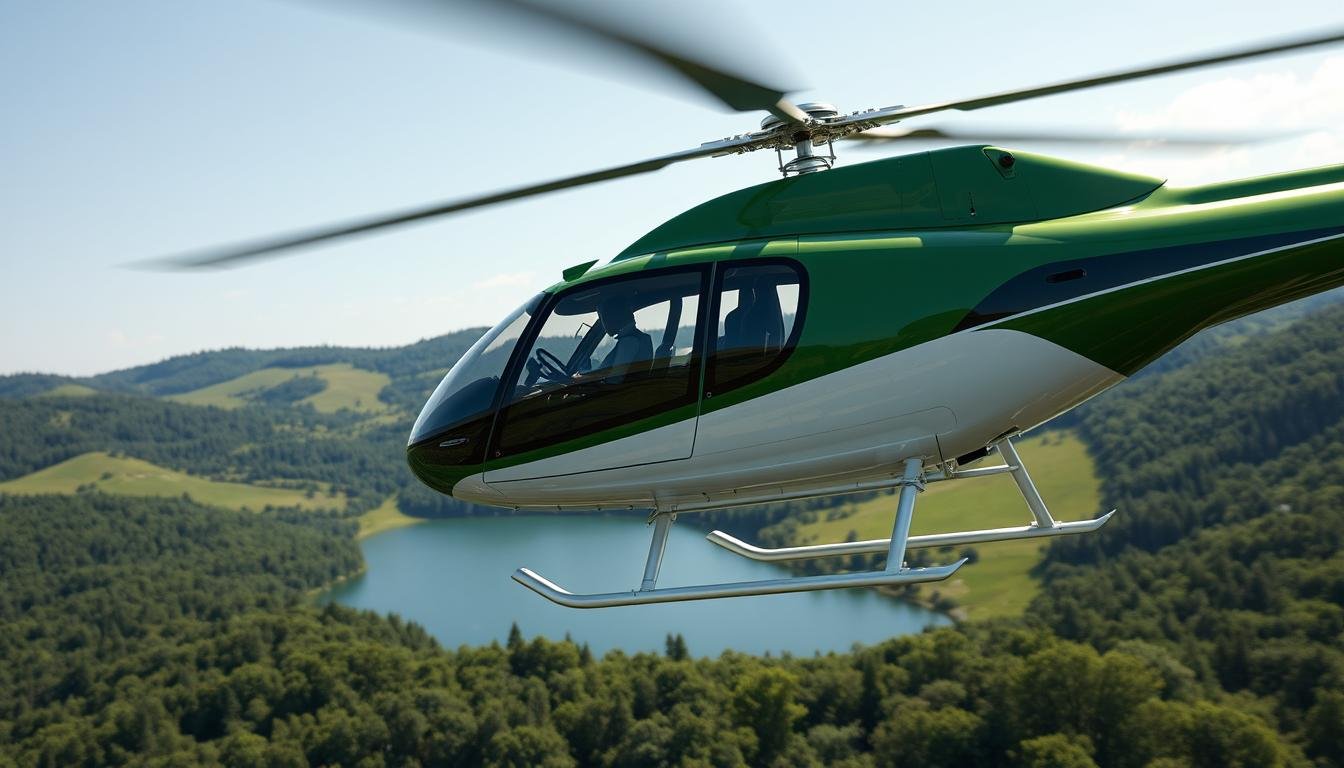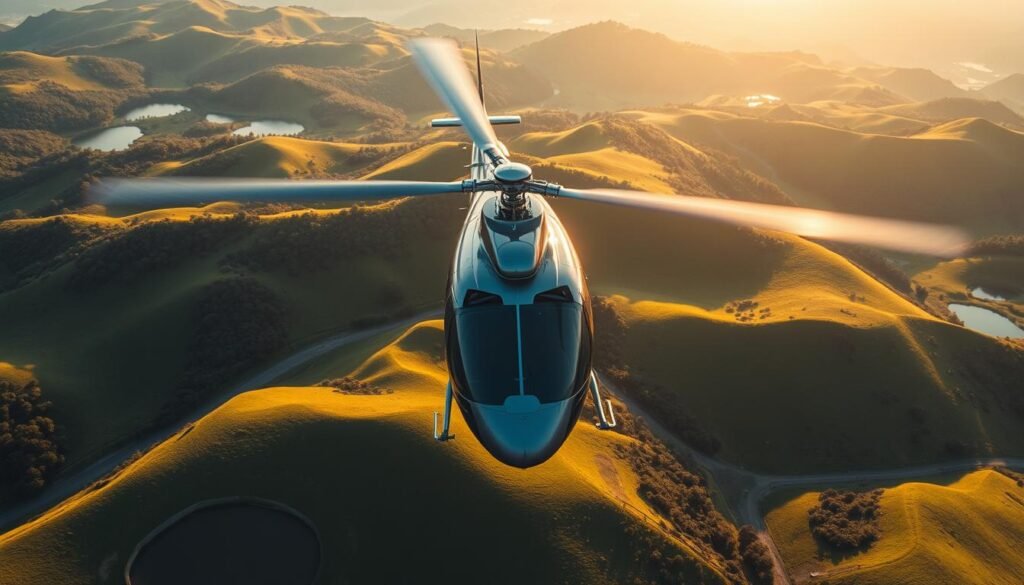Eco-Friendly Helicopter Tourism: Sustainable Travel Practices for a Greener Aviation Experience
Eco-friendly helicopter tourism now lets guests offset flights with traceable, Gold Standard certificates and local tree planting.
Alpine Helicopters runs a Green Initiative that pairs PlanetAir offsets with One Tree Planted. Guests may add a $2.00 donation that plants a local tree and funds certified offsets. Each tonne of GHG offset is traceable via unique certificates, giving clear proof of impact.
In the Grand Canyon, North Rim aerial experiences last about 25–30 minutes and include multilingual narration and headsets. An EcoStar “green” upgrade uses quiet technology to lower noise.
Safari Helicopters in Hawaii focuses on fuel-efficient aircraft, routes that avoid sensitive habitats, and ongoing support for reforestation. These measures protect views and wildlife while keeping the flight experience premium and safe.
In short: verified offsets, quiet-technology aircraft, and simple guest add-ons make sustainability a clear, measurable way for travelers to support conservation while enjoying spectacular views.
Key Takeaways
- Guests can add small donations to fund local tree planting and certified offsets.
- Gold Standard offsets offer traceable certificates for real accountability.
- Quiet-tech aircraft and smart routing reduce noise and protect habitats.
- Short, narrated flights maintain a premium experience with minimal disruption.
- Operators like Alpine Helicopters and Safari Helicopters integrate conservation into bookings.
- Learn more about responsible options at Safari Helicopters’ eco page and Helicopted’s guide.
Eco-Friendly Helicopter Tourism: What It Means For Today’s Traveler
Modern guests expect more than scenic rides. They want a clear link between breathtaking views and measurable conservation.
Operators like Safari Helicopters use fuel-efficient aircraft, plan routes that avoid sensitive habitats, and fund reforestation projects. Alpine Helicopters pairs PlanetAir Gold Standard offsets with One Tree Planted donations so a $2.00 add-on plants a local tree and funds traceable GHG certificates.
Pilots add value by narrating cultural context, local ecology, and stewardship tips. That turns a short ride into a learning moment and helps guests see real steps taken beyond marketing claims.
- Verified offsets and traceable certificates make climate commitments tangible.
- Maintenance, quiet tech, and careful routing reduce noise and emissions.
- Donation programs let travelers support habitat restoration directly.
For practical planning, compare providers and prioritize those that show quiet-technology investments and route sensitivity. Bookers can also review a dedicated helicopter tour resource to learn what to ask before they fly.
Carbon Offsets And Reforestation That Power Greener Tours
A practical mix of certified offsets and regional reforestation gives travelers a way to reduce the real impact of aerial sightseeing. Alpine Helicopters matches operational emissions with Gold Standard-certified projects through PlanetAir. Each tonne reduced is recorded with a unique, traceable certificate so contributors can verify climate benefits.
Gold Standard-Certified Carbon Offsets With PlanetAir
Gold Standard-Certified Carbon Offsets With PlanetAir
PlanetAir projects link emissions from a helicopter tour to an audited reduction. The unique certificates document where and how reductions occurred. That traceability builds trust and shows real accountability for the flight’s footprint.
Reforestation Partnerships Through One Tree Planted
Reforestation Partnerships Through One Tree Planted
One Tree Planted focuses planting in Alberta and British Columbia. Restoring forests there helps soil stability, supports biodiversity, and increases long-term carbon storage after recent wildfire and pest impacts.
Guest Donations That Plant Trees And Offset Flights
Guest Donations That Plant Trees And Offset Flights
Starting January 1, 2024, guests can add a $2.00 per-person donation. That plants one tree locally and directs remaining funds to Gold Standard offsets. This dual model gives immediate project accountability and a long-term path to sequestration.
- Traceable offsets tie emissions to verified reductions with unique certificates.
- Regional reforestation improves air and water quality while restoring habitat.
- Simple guest add-on makes participation easy and verifiable for travelers.

For more detail on the program and verification steps, see Alpine Helicopters’ Green Initiative.
Quiet Technology, Smarter Routes, And Efficient Aircraft
Quiet-system upgrades and smarter routing cut noise and emissions without shrinking the guest experience.
“Green” Helicopters With Quiet Tech To Protect Wildlife
EcoStar-style upgrades lower rotor and cabin noise while keeping 180-degree sightseeing windows for immersive views.
These retrofits help protect animal behavior and preserve the calm of natural areas. At the same time, they enhance passenger comfort and sightlines.
Eco-Conscious Flight Planning To Avoid Sensitive Habitats
Route design prioritizes altitude, distance from fragile zones, and time-of-day windows to reduce disturbance.
Pilots adapt routes dynamically to avoid wildlife, weather, or airspace constraints, balancing safety with conservation.
Maintenance And Fuel Efficiency To Reduce Emissions
A strict maintenance program and modern fuel-efficient airframes lower emissions per flight and cut noise footprints.
Integrated avionics and real-time monitoring support efficient power settings and smoother approaches.
“Low-noise performance can coexist with panoramic viewing and smooth ride quality.”
- Quiet-technology configurations reduce rotor and cabin noise and protect wildlife.
- Route design focuses on altitude and timing to minimize habitat impact.
- Well-maintained, fuel-efficient aircraft cut emissions and improve reliability.

Helicopter Tour Options In The United States With Sustainable Upgrades
Across the United States, upgraded sightseeing flights combine dramatic scenery with quieter aircraft and clear conservation choices.
Grand Canyon Flights: 25-30 Minutes, Aerial Views, And EcoStar Upgrades
A signature helicopter tour departs from Papillon’s South Rim terminal at Grand Canyon National Park Airport (GCN), 3568 Airport Rd, Grand Canyon Village, AZ 86023.
The standard experience lasts approximately 25–30 minutes and pairs vivid aerial views of the North Rim with headset narration, multilingual audio, and pilot communications.
Highlights often include Tower of Ra, Vishnu Schist, the Dragon Corridor, and panoramas of the Kaibab Forest.
Guests may select an EcoStar “green” upgrade—an option that adds quiet-technology systems and 180-degree windows for better photography and lower noise.
Hawaii Tours: Conservation Support And Minimal-Impact Sightseeing
Safari Helicopters in Hawaii runs fuel-efficient aircraft and plans routes to avoid sensitive habitats.
These tours showcase lava flows, rainforests, coastlines, and waterfalls while integrating conservation support and reforestation projects.
“Quiet upgrades and route planning let visitors enjoy iconic views while reducing disturbance to wildlife.”
| Region | Departure / Terminal | Duration | Notable Features |
|---|---|---|---|
| Grand Canyon, North Rim | Papillon — GCN South Rim Terminal | 25–30 minutes | Headset narration, EcoStar upgrade, Kaibab Forest, Tower of Ra |
| Hawaii (various islands) | Safari Helicopters bases | Variable (short scenic tours) | Fuel-efficient aircraft, habitat-aware routing, conservation support |
| National Providers | Regional terminals | Short scenic flights | Quiet tech options, private upgrades, ground tour pairings |

- Check-in is at the GCN South Rim terminal for the Grand Canyon tour; logistics are streamlined for quick boarding.
- Travelers can add a Hummer ground tour to combine rim viewpoints with the aerial segment for a fuller tour.
- Across the United States, providers increasingly pair efficient fleets with eco-conscious routing to deliver a reliable flight experience.
Guest Experience: Views, Time In The Air, And Comfort
Guests begin with a clear pre-flight routine that balances safety with relaxed expectation. At Grand Canyon departures, passengers are asked to arrive about 30 minutes before lift-off for check-in, briefings, and seat assignment.
Check-In Timing, Multilingual Narration, And Pilot Communications
Multilingual narration is available onboard in English, Mandarin, Cantonese, Dutch, French, German, Italian, Japanese, Korean, and Spanish. This expands accessibility so more travelers understand the landscape and history while aloft.
Two-way headset communications keep the pilot connected with passengers. That live exchange answers route and sight questions in real time and improves comfort for the whole group.

- Consistent check-in: Arrive 30 minutes early for safety and smooth boarding.
- Comfort features: Climate control, oversized windows, and low-vibration seating enhance views and photography on a helicopter tour.
- Upgrade choices: Guests may choose to privatize the aircraft or select the EcoStar option for quieter cabins and larger windows.
- Efficient flow: Clear wayfinding and timely boarding keep the day on schedule so air time remains the highlight.
“Clear briefings and good headset communications make the flight feel effortless and focused on the scenery.”
For travelers planning island flights, reviews and practical tips for similar helicopter tours in Kauai offer useful comparisons on check-in, upgrades, and comfort.
Community And Environmental Impact Beyond The Flight
Local operators channel ticket revenue into on-the-ground projects that restore habitats and support community resilience. This expands the value of a single booking, turning short scenic experiences into longer-term benefits for people and nature.
Supporting Local Conservation And Biodiversity
Safari Helicopters supports conservation and reforestation projects across Hawaii. Proceeds fund local efforts that help native species and recover areas affected by wildfire or invasive plants.
Alpine Helicopters pairs a per-person $2.00 donation with One Tree Planted to restore forests in Alberta and British Columbia. That donation plants one tree locally while funding additional offset work.
Traceable Certificates And Transparent Climate Projects
Alpine also funds Gold Standard-certified PlanetAir projects. Each tonne of GHG reduced carries a unique, traceable certificate so buyers can verify outcomes.
Responsible operators explain project details clearly. That transparency helps guests link a single tour purchase to measurable results rather than vague claims.

| Program | Partner | Primary Benefit | How It Is Tracked |
|---|---|---|---|
| Local Reforestation | One Tree Planted | Habitat recovery, carbon storage | Planting reports, GPS plots |
| Offset Projects | PlanetAir (Gold Standard) | Verified GHG reductions | Unique certificates per tonne |
| Community Grants | Regional NGOs | Wildfire recovery, invasive species control | Fund usage reports, partner audits |
- Responsible operators extend impact beyond a single tour by funding restoration and local programs.
- When aerial views are paired with education, guests often continue to support conservation after they return home.
Conclusion
A Responsible Choice Makes Every Minute Aloft Count. Responsible providers let travelers tailor a short tour so that a single booking supports verified climate projects and local reforestation.
Alpine Helicopters and Safari Helicopters link Gold Standard PlanetAir certificates with One Tree Planted donations, offer EcoStar quiet-technology upgrades, and use multilingual narration and route planning to protect sensitive habitats while delivering memorable views.
Key Benefits: measurable offsets, local tree planting with a $2.00 add-on, quieter fleets, and efficient check-in that enhances guest time and comfort on each helicopter tour.
FAQ
What does eco-friendly helicopter tourism mean for today’s traveler?
It means choosing flights that minimize environmental harm through cleaner engines, quieter rotor designs, and careful route planning. Travelers look for operators that offset emissions, support reforestation, and work with verified carbon programs to reduce the climate impact of scenic flights.
How do carbon offsets and reforestation make tours greener?
Carbon offsets fund verified projects that remove or avoid greenhouse gases, while reforestation stores carbon long-term and restores habitat. Reputable providers use Gold Standard or similar certifications to ensure each flight’s emissions are matched by measurable climate action.
Are Gold Standard-certified offsets important?
Yes. Gold Standard certification verifies that projects deliver real climate and social benefits. Passengers should prefer operators that purchase certified offsets to ensure transparency and lasting impact from their contributions.
Can guests directly support tree planting or conservation?
Many operators offer optional guest donations at booking or during check-in. Those funds often go to partners like One Tree Planted or local conservation groups, creating a direct link between visitor spending and restoration work.
What quiet technologies help reduce noise for wildlife and communities?
Innovations include low-noise rotor blade shapes, vibration dampers, and acoustic fairings. Combining these features with altitude and route restrictions helps minimize disturbance to wildlife and nearby residents.
How does eco-conscious flight planning protect sensitive habitats?
Pilots use routes that avoid critical nesting or migration zones, fly at higher altitudes over protected areas, and schedule flights outside sensitive periods. This planning reduces disturbance while preserving the viewing experience.
What maintenance and fuel-efficiency measures lower emissions?
Regular engine tuning, lightweight interiors, and aerodynamic upgrades improve fuel burn. Operators that adopt these practices lower per-flight emissions and extend aircraft life, supporting more sustainable operations.
Which U.S. tour options offer sustainable upgrades?
Popular scenic routes such as Grand Canyon and Hawaii flights now include quieter models, carbon-offset packages, and conservation partnerships. Look for operators that list specific upgrades like EcoStar or quieter rotor systems.
How long are typical Grand Canyon and Hawaii flights?
Grand Canyon sightseeing flights commonly run 25–30 minutes for standard circuits, while Hawaii excursions vary by island and itinerary. Operators provide clear durations so guests can choose the best time-in-air for their plans.
What should guests expect regarding check-in and onboard narration?
Guests should arrive early for safety briefings and weight checks. Many tours offer multilingual narration and pilot commentary to enhance interpretation while keeping groups small and comfortable.
How do operators support local conservation and biodiversity?
Reputable companies donate a portion of proceeds, fund habitat restoration, and partner with local NGOs. These efforts help protect species, maintain trails, and support community-led stewardship.
Are climate projects and offset purchases transparent and traceable?
Transparent operators provide certificates, project IDs, and third-party verification so guests can trace where funds go. This traceability ensures funds support real, measurable climate or conservation outcomes.
What should travelers look for when choosing a greener flight operator?
Seek evidence of certified offsets, partnerships with credible reforestation groups, quieter aircraft technology, clear maintenance records, and detailed information about route planning and community benefits. breathtaking experiences as well.
Related Articles
- Helicopter City Tours: The Best Urban Destinations to See from the Sky
- The Eco-Friendly Side of Helicopter Tourism: Sustainable Travel Practices
- Helicopter Tours vs. Plane Tours: Which Offers the Better Experience?
- Island Hopping by Helicopter: The Best Destinations for Aerial Exploration
- How Helicopters Are Revolutionizing Adventure Travel
More from This Category
- Helicopter Safari Adventures: Exploring Wildlife from Above
- The Most Breathtaking Aerial Views You Can Only Experience by Helicopter
- Helicopter Travel Tips: What to Know Before Your First Flight
- Why Helicopter Tours Are the Ultimate Luxury Travel Experience
- Top 10 Scenic Helicopter Tours Around the World



